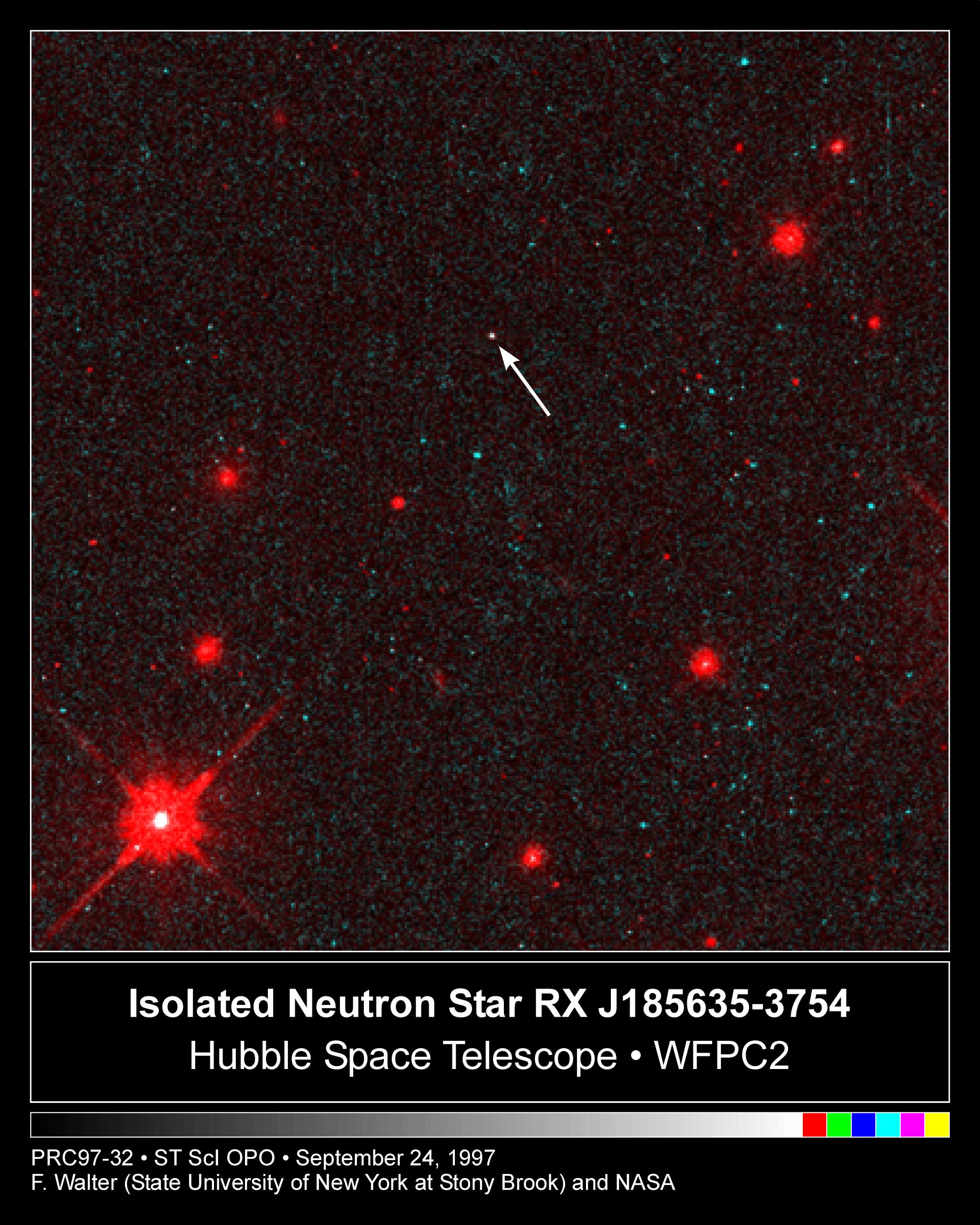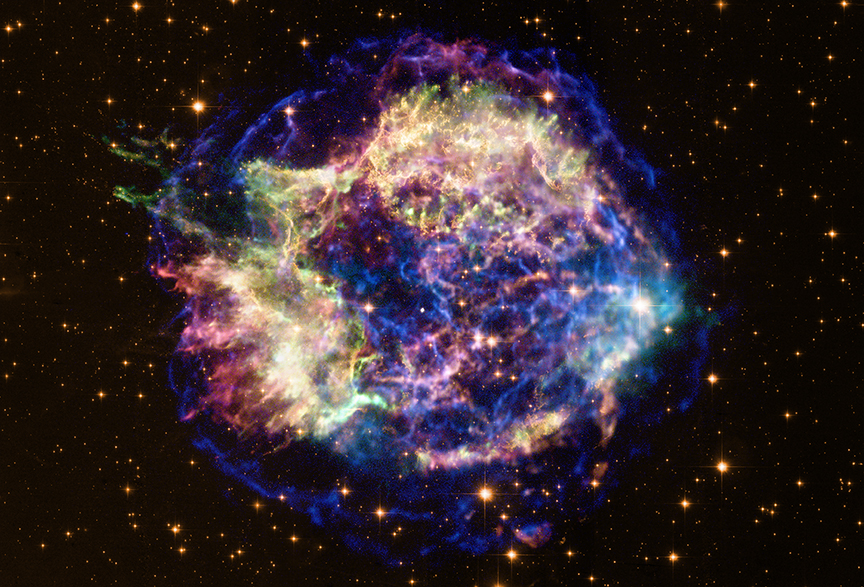Neutron Stars
Four neutron star questions and answers
by
Andrew W.
Steiner.
Links to Wikipedia
are blue, and links to
non-Wikipedia websites are
darker blue.
What is a neutron star?
A neutron star is the final product in the evolution of medium-sized "main-sequence" stars, with masses between about 8 and 20 times the mass of the sun. (Main-sequence star are "normal" stars as opposed to giants, supergiants, white dwarfs, neutron stars, etc. Most of the stars in the night sky are main-sequence stars.) Neutron stars are small, nearly spherical, and consist mostly of a fluid of neutrons, protons, electrons.
The transition between a main-sequence star and a neutron star is a "core-collapse supernova". For more introduction on stellar evolution, try "Stellar Evolution in Pictures".
What do neutron stars look like?
(For more neutron star-related pictures, a great place to go is the Chandra website.)

(F.
Walter & NASA) This is a
Hubble photo of
the neutron star RXJ1856.5-3754. Neutron
star images in the visible wavelengths are
difficult to obtain. This picture is
possible because this neutron star is
relatively close, about 400 light years
away.

(X-ray: NASA/CXC/UNAM/Ioffe/D.Page,P.Shternin et
al; Optical: NASA/STScI; Illustration:
NASA/CXC/M.Weiss)
This is a combined Chandra and
Hubble
image of the
Cas
A supernova remnant. The neutron star is the
small white dot near the center. This neutron
star is 11,000 light years away and the supernova
which created the neutron star was observed in
1680.
Why should we care about neutron stars?
First, neutron stars are a novel way of understanding how neutrons and protons interact and how QCD (quantum chromodynamics) works. Neutron stars are one of the few places in the universe where we can study matter which is both dense and cold.
Second, neutron stars are central part of the process which creates some of the nuclei heavier than iron (the "r-process"). Almost all of the iodine in your body (iodine is important for thyroid function) is likely created in the merger of two neutron stars.
What makes neutron stars cool?
Good question! I'm so glad you asked. Here is a list, in no particular order.
Pressure and density: neutron stars contain matter at tremendously high pressures and densities. The central mass density may be as large as one thousand trillion ( \( 10^{15} \) ) times the density of water. The central pressure may be as large as ten million trillion ( \( 10^{19} \) ) times the pressure in the center of the sun [1].
Gravitational Waves: The merger of two neutron stars generates gravitational waves, periodic changes in the nature of space and time. LIGO recently made the first detection of gravitational waves which originated in a merger a hundred million light years away. National Geographic has a short page on this topic.
Magnetic fields: Neutron stars have the largest magnetic fields in the universe, \(10^{15}~\mathrm{G}\), a hundred million times stronger than any macroscopic magnetic field on earth [2]. Neutron stars with particularly large magnetic fields are referred to as magnetars.
Strongest known material: A series of two papers, Caplan et al. (2018) and Horowitz et al. (2009) have shown that the neutron star crust may be the strongest material known, billions of times stronger than steel and able to tolerate tremendous strain forces.
Little Green Man: Neutron stars were discovered by Jocelyn Bell Burnell, who found an unexplained radio signal which she temporarily named "LGM-1", but is now known as PSR J1921+2153.
Sound speed: Neutron stars have the fastest sound in the universe. The sound speed near the center of some neutron stars must be at least half the speed of light [3].
Explosions: Accreting neutron stars often exhibit "X-ray bursts". Some of these explosions emit more energy one month than the sun emits in 8 years [4].
Starquakes: At least some neutron stars are seismically active. The associated starquakes can be measured on the Richter scale. The starquakes can be as large as 23 on this scale, while the largest quakes on earth reach only 9.5. Starquakes can result in tremendous explosions which release bursts of high-energy X-rays and gamma-rays. A particularly large explosion of this type was observed from the magnetar called SGR 1806-20 in 2004. This explosion was so intense that, when the gamma rays reached the earth (after traveling 50,000 light years) it dramatically impacted the Earth's ionosphere for a short time.
High temperature superconductors: Protons in the neutron star are believed to have critical temperatures of \( 10^{9}~\mathrm{K} \), much larger than the current \( 200~\mathrm{K} \) record held by terrestrial superconductors.
Supersolid: The neutron star crust is expected to have a neutron superfluid and a crystal lattice, and is thus a "supersolid". Long sought-after evidence for supersolids in laboratories on earth is still very preliminary.
Dragging space-time: Neutron stars are so dense that, when they rotate, they drag space and time along with them. Even photons outside the neutron star are forced to rotate in the same direction.
More light-bending: When you see the moon in the sky, you see about half of the surface. When Hubble sees a neutron star, it sees about 60% of the surface. Light is bent by the neutron star's extreme gravitational potential and this bending means you can see partially "around the back side" of the neutron star. In many cases, you can fully see both the north and south poles. A good explanation of this was described by Lisa Drummond at astrobites.
Short GRBs: Neutron star mergers are the likely source of "short gamma-ray bursts". Gamma-ray bursts were first detected in 1967 by satellites monitoring compliance with the 1963 nuclear test ban treaty and then declassified in the 1970s. Gamma-ray bursts are now routinely detected and an important part of understanding our universe.
Where can I learn more?
Try any of the following links:
- The neutron star page in the Study Astronomy Online encyclopedia of Astronomy at Swinburne University,
- the "Imagine the Universe" page at Goddard Space Flight Center,
- A neutron star infographic from H.F. Stevance.
- the KIPAC neutron star page,
- the NuSTAR neutron star page,
- Cole Miller's introduction, or
- Robert Duncan's magnetar page.
Notes
- Note 1: The pressure in the center of the earth is about \(4 \times 10^{11}~\mathrm{Pa} \), the pressure in the center of the sun is about \( 3 \times 10^{16}~\mathrm{Pa} \) and the pressure in the center of a neutron star could be as large as \( 1000~\mathrm{MeV}/\mathrm{fm}^3 \approx 1.6 \times 10^{35}~\mathrm{Pa} \).
- Note 2: Largest magnetic field on earth is about \( 1000~\mathrm{T} \) or \( 10^{7}~\mathrm{G} \) and neutron star magnetic fields are as large as \( 10^{15}~\mathrm{G} \).
- Note 3: For the stodgy academic version of this result, see this paper.
- Note 4: The energy output of an X-ray superburst may be as large as \(10^{42}~\mathrm{erg}\), where as the luminosity of the sun is \(4\times10^{33}~\mathrm{erg}/\mathrm{s}\)

This work is licensed under a Creative Commons Attribution-NonCommercial-ShareAlike 4.0 International License. Image credits are given in the caption for each image.
Back to Andrew W. Steiner at the University of Tennessee.